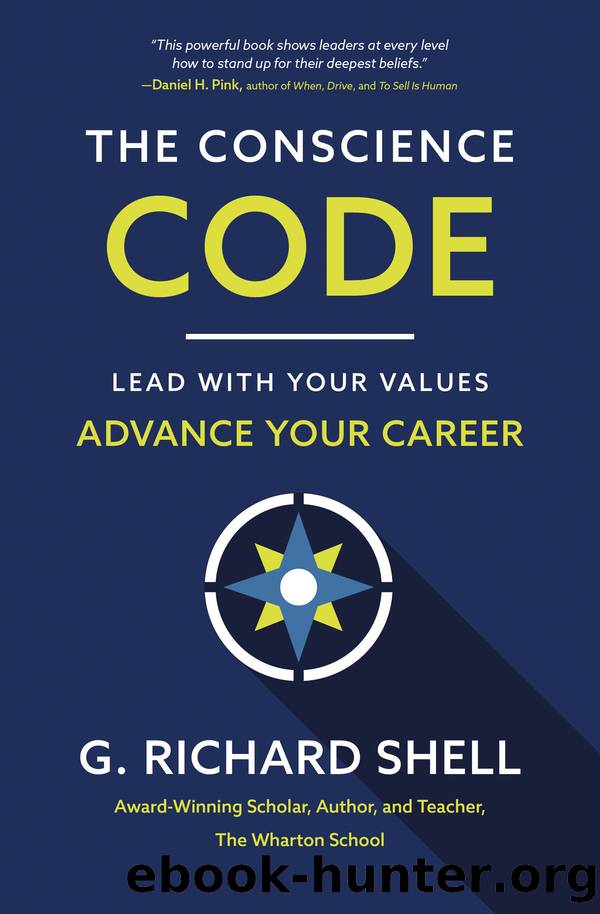The Conscience Code by G. Richard Shell

Author:G. Richard Shell
Language: eng
Format: epub
Publisher: Harpercollins Leadership
Published: 2021-04-02T00:00:00+00:00
Wrapping It Up: The Power of Two vs. the Close, the Many, and the Powerful
It is impossible to say whether Shultz or Cheung, acting separately, could have brought about the result they did. But it seems clear that their collective power was more than the sum of its two parts. Shultz had hoped, when he brought Cheung to meet his grandfather the day before she resigned, that they might break the spell Holmes had cast on the stubborn, crusty former secretary of state. But that had not worked. All George Shultz had seen were two young, inexperienced idealists who did not grasp the âbig pictureâ of the medical device business. Nevertheless, like Aschâs subjects who benefited from a âtrue partner,â they reinforced each otherâs confidence in the truth of what they could see with their own eyes. And with two voices on the side of this truth, they proved to be persuasive, reliable sources for the Wall Street Journal.
Their story demonstrates the power of an ally when you encounter the pressures of a real-world conflict. Shultz and Cheung fed off each otherâs energies, advanced each otherâs strategic thinking, and provided independent, credible information from the inner workings of a corrupt organization that could be used as evidence by the legal system. But they faced consistent opposition from George Shultz and were intimidated, at least initially, by the positive media coverage given the charismatic Elizabeth Holmes and celebrity status of many Theranos stakeholders.
In short, Theranos was a âperfect stormâ of the pressures identified as the enemies of ethical conduct earlier in the book:
Peer Pressure. Shultzâs and Cheungâs peers were passive players in the Theranos fraud, going along to get along. The weight of peer pressure was against them.
Authority Pressure. The top officers at Theranos brought direct pressure on Shultz and Cheung to stop their questioning and go along with the herd. Balwani personally berated them both, threatening them with termination. Even after they left, the firmâs lawyers and investigators stalked them and issued more threats to curtail their cooperation with the media.
Incentives. The Walgreens contract with its urgent deadline requiring the Edison to be a working product provoked the entire scandal. Everyone was working feverishly to make the deadline, not to create a safe, useful medical device.
Roles. Time after time, Shultzâs and Cheungâs junior roles in the organization were held up as reasons for them to stand down. They were told they were acting outside their areas of expertise and should let other, more senior people take responsibility for these important decisions.
Systems. When an entire company goes rogue, people like Shultz and Cheung face more than individualized opposition. Investors, bankers, other employees, and even the media may have a stake in maintaining the illusion that nothing is wrong. Fearful of losses and embarrassment, they form a wall of opposition to anyone who might burst the bubble.
Download
This site does not store any files on its server. We only index and link to content provided by other sites. Please contact the content providers to delete copyright contents if any and email us, we'll remove relevant links or contents immediately.
| Ethics | Etiquette |
| Fashion & Image | Health & Stress |
| Motivation & Self-Improvement | Work Life Balance |
| Workplace Culture |
Tools of Titans by Timothy Ferriss(8311)
Change Your Questions, Change Your Life by Marilee Adams(7692)
Deep Work by Cal Newport(6970)
Playing to Win_ How Strategy Really Works by A.G. Lafley & Roger L. Martin(6096)
Man-made Catastrophes and Risk Information Concealment by Dmitry Chernov & Didier Sornette(5958)
Digital Minimalism by Cal Newport;(5712)
Big Magic: Creative Living Beyond Fear by Elizabeth Gilbert(5682)
The Slight Edge by Jeff Olson(5383)
Ego Is the Enemy by Ryan Holiday(5352)
The Motivation Myth by Jeff Haden(5176)
The Laws of Human Nature by Robert Greene(5090)
Stone's Rules by Roger Stone(5055)
Tuesdays with Morrie by Mitch Albom(4733)
Eat That Frog! by Brian Tracy(4484)
Rising Strong by Brene Brown(4415)
Skin in the Game by Nassim Nicholas Taleb(4208)
Bullshit Jobs by David Graeber(4143)
The Money Culture by Michael Lewis(4141)
Skin in the Game: Hidden Asymmetries in Daily Life by Nassim Nicholas Taleb(3964)
